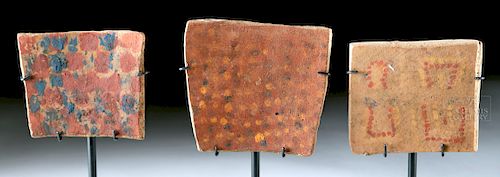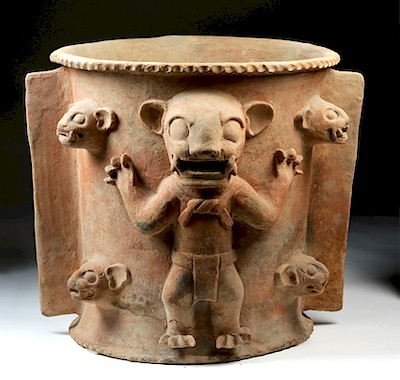Lot of 3 Inca Chucu Terracotta Plaques
Lot 97c
About Seller
Artemis Gallery
686 S Taylor Ave, Ste 106
Louisville, CO 80027
United States
Selling antiquities, ancient and ethnographic art online since 1993, Artemis Gallery specializes in Classical Antiquities (Egyptian, Greek, Roman, Near Eastern), Asian, Pre-Columbian, African / Tribal / Oceanographic art. Our extensive inventory includes pottery, stone, metal, wood, glass and textil...Read more
Estimate:
$1,000 - $1,500
Absentee vs Live bid
Two ways to bid:
- Leave a max absentee bid and the platform will bid on your behalf up to your maximum bid during the live auction.
- Bid live during the auction and your bids will be submitted real-time to the auctioneer.
Bid Increments
| Price | Bid Increment |
|---|---|
| $0 | $25 |
| $300 | $50 |
| $1,000 | $100 |
| $2,000 | $250 |
| $5,000 | $500 |
| $10,000 | $1,000 |
| $20,000 | $2,500 |
| $50,000 | $5,000 |
| $100,000 | $10,000 |
| $200,000 | $20,000 |
About Auction
By Artemis Gallery
Dec 6, 2018
Set Reminder
2018-12-06 10:00:00
2018-12-06 10:00:00
America/New_York
Bidsquare
Bidsquare : DAY 2 : Pre-Columbian, Ethnographic & Fine Art
https://www.bidsquare.com/auctions/artemis-gallery/day-2-pre-columbian-ethnographic-fine-art-3699
Day 2 of an important 2-dy auction featuring ancient and ethnographic art from around the world. Today's sale will feature Pre-Columbian, Native American, African / Tribal, Ethnographic, Spanish Colonial, Fine Art, much more. Artemis Gallery info@artemisgallery.com
Day 2 of an important 2-dy auction featuring ancient and ethnographic art from around the world. Today's sale will feature Pre-Columbian, Native American, African / Tribal, Ethnographic, Spanish Colonial, Fine Art, much more. Artemis Gallery info@artemisgallery.com
- Lot Description
Pre-Columbian, southern Peru, Inca hinterlands (Chucu), ca. 1000 to 1500 CE. A trio of roughly square ceramic panels, each gently concave, with one side painted with interesting motifs. One is red and blue large dots, another is red with bright yellow and black dots, and the third features a labyrinthine motif made of red and yellow dots. Size: 4" W x 3.7" H (10.2 cm x 9.4 cm); 6.5" H (16.5 cm) on included custom stand.
These plaques were made by smashing large vessels and painting the fragments. They have been discovered in a number of different contexts: beneath wall foundations, in graves, with animal sacrifices, and cached in prominent places in the landscape, like in springs, rock hollows, and atop hills. They are often discovered in pairs, with the painted surfaces placed so that they are facing each other, sometimes wrapped in leaves or even gold sheet. Although the tablet tradition began centuries before, the time period that this one comes from represents the height of the tablet tradition, and corresponds to an intensification of agriculture, the rise of interregional trade networks, and the ascendancy of certain important confederations of clans. Into this potent mix, the Inca expanded into the region and the tablet tradition abruptly ended. It seems likely that the Inca, who colonized regions in part by sponsoring local ritual activities, outlawed the creation of religious tablets like this because they saw them as a threat to their trade in sacrificial alpacas, corn beer, and cloth.
Provenance: private Hawaii, USA collection; ex-Hillberg collection, California, USA
All items legal to buy/sell under U.S. Statute covering cultural patrimony Code 2600, CHAPTER 14, and are guaranteed to be as described or your money back.
A Certificate of Authenticity will accompany all winning bids.
We ship worldwide and handle all shipping in-house for your convenience.
#141181All three are intact. Some fading to pigment, but most of the motifs are still clear.Condition
- Shipping Info
-
All shipping is handled in-house for your convenience. Your invoice from Artemis Gallery will include shipping calculation instructions. If in doubt, please inquire BEFORE bidding for estimated shipping costs for individual items.
-
- Buyer's Premium



 EUR
EUR CAD
CAD AUD
AUD GBP
GBP MXN
MXN HKD
HKD CNY
CNY MYR
MYR SEK
SEK SGD
SGD CHF
CHF THB
THB














